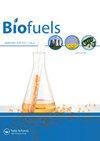Evaluation of biogas production and pollutant removal efficiency of two-phase anaerobic digestion treating slaughterhouse effluent
IF 2.6
4区 工程技术
Q3 ENERGY & FUELS
引用次数: 1
Abstract
Abstract Treatment of slaughterhouse and other agro-processing industry effluent has become important due to continuous global population growth and meat demand, particularly in developing countries, for sustainable biowaste management as well as value additions such as biofuel. Therefore, the objective of the study was to evaluate the performance of two-phase anaerobic digestion of slaughterhouse wastewater in terms of biogas production, methane yield, and removal efficiencies of organic matter, total nitrogen, and total phosphorus. Two consecutively connected 40 L galvanized metal anaerobic batch bioreactors were used to conduct the experiment. The total phosphorus removal efficiencies of hydrolytic-acidogenic reactor and methanogenic reactor were 13.34% and 16.58%, respectively. Total chemical oxygen demand, soluble chemical oxygen demand, biological oxygen demand, total dissolved solids, total solids, total suspended solids, volatile solids, and turbidity had overall removal efficiencies of 82.87, 88.53, 93.32, 75.35, 95.55, 98.95, 97.42 and 98.06%, respectively. Biogas production of 189.45 mL/day with methane and carbon dioxide compositions of 67.69% and 29.9%, respectively, was also achieved. It was concluded that the two-phase anaerobic digestion of slaughterhouse wastewater shows substantial organic matter removal efficiencies and biogas production.两相厌氧消化处理屠宰场污水产气量及污染物去除率评价
摘要由于全球人口的持续增长和肉类需求,特别是发展中国家的需求,屠宰场和其他农产品加工业废水的处理对于可持续的生物废物管理以及生物燃料等增值来说变得非常重要。因此,本研究的目的是评估屠宰场废水的两相厌氧消化在沼气产量、甲烷产量以及对有机物、总氮和总磷的去除效率方面的性能。两个连续连接40 采用L型镀锌金属厌氧间歇式生物反应器进行实验。水解产酸反应器和产甲烷反应器的总磷去除率分别为13.34%和16.58%。总化学需氧量、可溶性化学需氧量和生物需氧量、总溶解固体、总固体、总悬浮固体、挥发性固体和浊度的总去除率分别为82.87、88.53、93.32、75.35、95.55、98.95、97.42和98.06%。沼气产量189.45 甲烷和二氧化碳的组成分别为67.69%和29.9%。结果表明,屠宰场废水的两相厌氧消化具有显著的有机物去除效率和沼气产量。
本文章由计算机程序翻译,如有差异,请以英文原文为准。
求助全文
约1分钟内获得全文
求助全文
来源期刊

Biofuels-Uk
Energy-Renewable Energy, Sustainability and the Environment
CiteScore
5.40
自引率
9.50%
发文量
56
期刊介绍:
Current energy systems need a vast transformation to meet the key demands of the 21st century: reduced environmental impact, economic viability and efficiency. An essential part of this energy revolution is bioenergy.
The movement towards widespread implementation of first generation biofuels is still in its infancy, requiring continued evaluation and improvement to be fully realised. Problems with current bioenergy strategies, for example competition over land use for food crops, do not yet have satisfactory solutions. The second generation of biofuels, based around cellulosic ethanol, are now in development and are opening up new possibilities for future energy generation. Recent advances in genetics have pioneered research into designer fuels and sources such as algae have been revealed as untapped bioenergy resources.
As global energy requirements change and grow, it is crucial that all aspects of the bioenergy production process are streamlined and improved, from the design of more efficient biorefineries to research into biohydrogen as an energy carrier. Current energy infrastructures need to be adapted and changed to fulfil the promises of biomass for power generation.
Biofuels provides a forum for all stakeholders in the bioenergy sector, featuring review articles, original research, commentaries, news, research and development spotlights, interviews with key opinion leaders and much more, with a view to establishing an international community of bioenergy communication.
As biofuel research continues at an unprecedented rate, the development of new feedstocks and improvements in bioenergy production processes provide the key to the transformation of biomass into a global energy resource. With the twin threats of climate change and depleted fossil fuel reserves looming, it is vitally important that research communities are mobilized to fully realize the potential of bioenergy.
 求助内容:
求助内容: 应助结果提醒方式:
应助结果提醒方式:


